
In this article, we rounded up 16 terms from the history of the arts. Most likely, you have never heard of them. There's some French and a lot of Italian, and even one in Latin. Learning these terms is like a crash course in art history - from very ancient times all through contemporary art. Memorizing just a few terms should be enough to become art savvy by the end of the article!
Jump into the art history discourse with ease. The terms are grouped and ordered according to chronological periods in art history.
Horror vacui is a Latin term meaning "fear of empty space." This fear is based on a belief that evil spirits will nest in the spaces left in a painting. The artists used to insert decorations and symbols between objects in their paintings to leave no room for spirits. Beginning as early as ancient Egyptian art, we can see densely decorated paintings.
Above is a detail from an ancient Greek vase depicting a man riding a chariot carried by a horse. Notice how the artist filled the empty space between the horse's legs with a geometric symbol. This symbol repeats throughout the vase.
Kouros and Kore
Kouros is the ancient Greek word for "boy." The plural form is kouroi. Kore is the word for "girl," korai in plural.
Kouros sculptures were made as trophies for winners of the ancient Olympic games. They had a ritualistic meaning too - they were tokens to the god Apollo.
These are early forms of the later realistic, detailed, anatomically accurate classic Greek sculptors we know today. The refinement of representation of the human body happened, in large part, due to the Olympic games in which men participated fully naked. This allowed sculptors to study the human body.
Each sculpture was made in the shape of the winner but had to follow certain standards. Koroi were always naked, standing straight up with their weight evenly and symmetrically distributed on both feet, and their arms close to the body. The muscles are etched on. The face wears an archaic smile.
Korai are always dressed in long dresses, standing with their feet close together. One hand is usually placed on the chest, and the face also wears an archaic smile.
Archaic smiles are a convention of that era. The meaning of the smile is unknown, but it appears in most sculptures of that era.
This word means "to carry on both sides." Amphora is the single form, whereas amphorae is the plural. Any vase you hold on both sides can be called an amphora. The word amphitheater derives from amphora and is used to describe two theaters attached to create a round building, like the Colosseum.
There were 15 different shapes of vases in ancient Greek pottery. Some, like the Kylix, were used for food and drink, while others, like the Loutrophoros, had a strictly ritualistic use. All of them were painted and can be considered ancient Greek pottery art. Amphora was another shape for a pottery vase. Amphoras had various uses, and not all of them were decorated.
Caryatids are female figures functioning as columns in classical architecture. They look like refined sculptures, but they also support the weight of a structure. They stand in contrapposto, wearing a draped tunic with many folds. Their bodies are anatomically accurate.
Atlantes are the male figure columns. In the photo above, you can see the most famous and celebrated caryatids, those on the porch of the Erechtheion in Athens, Greece, a temple for the goddess Athena.
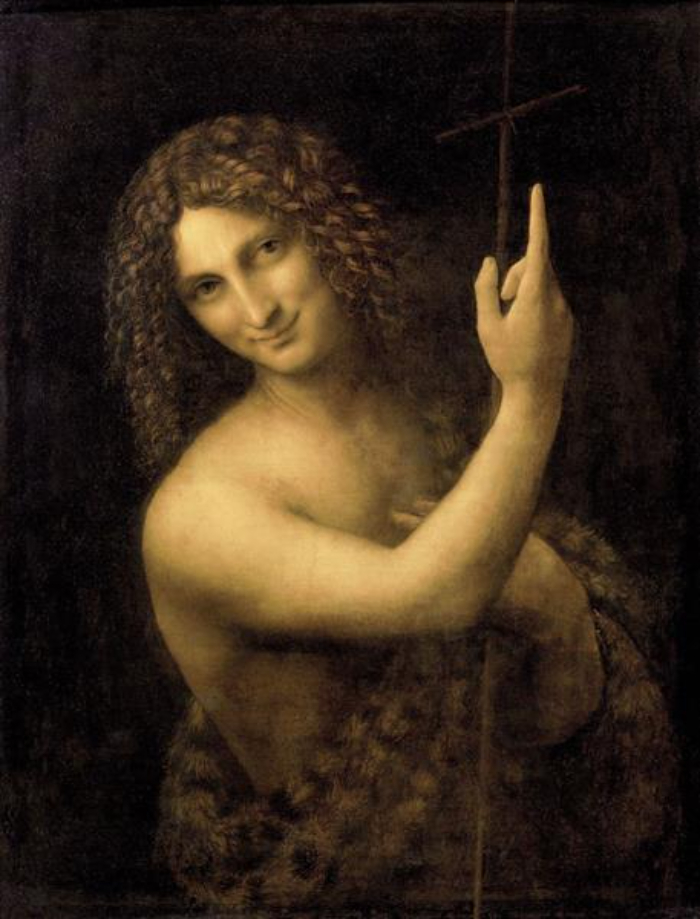 St. John the Baptist, by Leonardo Da Vinci, 1515/Source
St. John the Baptist, by Leonardo Da Vinci, 1515/SourceContrapposto
 David, by Michelangelo, 1501-1504 (left), and The Birth of Venus, by Sandro Botticelli, 1485-1486 (right)/Source, Source
David, by Michelangelo, 1501-1504 (left), and The Birth of Venus, by Sandro Botticelli, 1485-1486 (right)/Source, SourceContrapposto is Italian for "opposite pose." This term describes a relaxed, asymmetrical natural posture in which the weight is placed on one leg, twisting and affecting the hips, knees, shoulders, torso, and head. It is mostly used when discussing sculpture.
Contrapposto was invented by the Greeks in the fifth century BC, as an ideal pose for the realistic representation of the human body. The term is often used to describe sculptures rather than paintings. The most famous objects in art history standing in contrapposto are Venus in Sandro Botticelli's The Birth of Venus and Michelangelo's David (1501-1504).
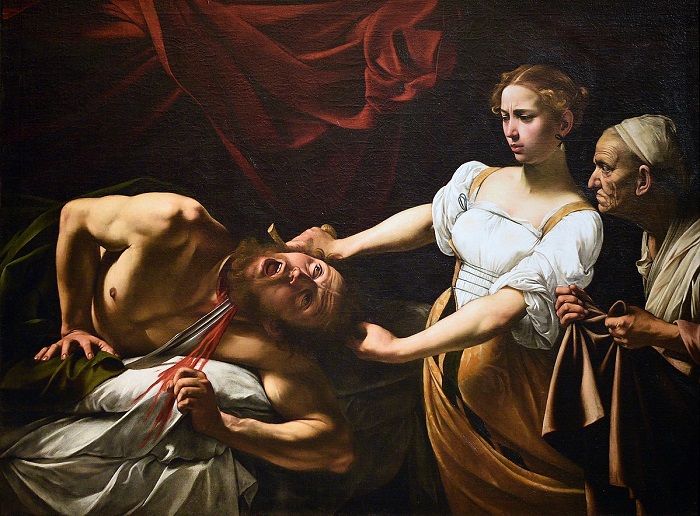 Judith Beheading Holofernes, by Caravaggio, 1602/Source
Judith Beheading Holofernes, by Caravaggio, 1602/Source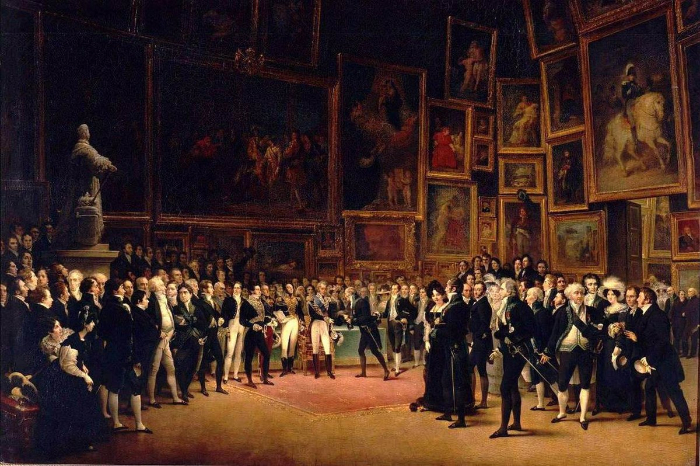 Charles X Distributing Awards to the Artists at the Close of the Salon of 1824, by François-Joseph Heim, 1827/Source
Charles X Distributing Awards to the Artists at the Close of the Salon of 1824, by François-Joseph Heim, 1827/SourceThe Salon was an official art exhibition sponsored by the French government. Young artists from the Académie Royale de Peinture et de Sculpture displayed their works here. It first opened in 1667 under Louis XIV's reign, in the Salon d’Apollon of the Louvre in Paris. Starting in 1737, it became an annual event. In 1748, a jury was set up to determine who could and couldn't present their works at the Salon, which was highly conservative.
Many artists gained fame in the Salon, but many others made their name by undermining the system. The Impressionists, for example, launched their movement with an independent exhibition. Never before had anyone dared to do that! Other artists who presented their works in the Salon des Refusés (Salon of the Refused, a place where painters would exhibit paintings if the jury denied them access to the official Salon) later made it into the hall of fame of art history: Paul Cézanne, Camille Pissarro, and Édouard Manet.
Several other Salons have opened, some with a jury and some without. Some are still standing today, while others closed long ago. Salon exhibitions are very intimate thanks to their distinctive hanging pattern, which can be seen in the painting above.
Alla prima
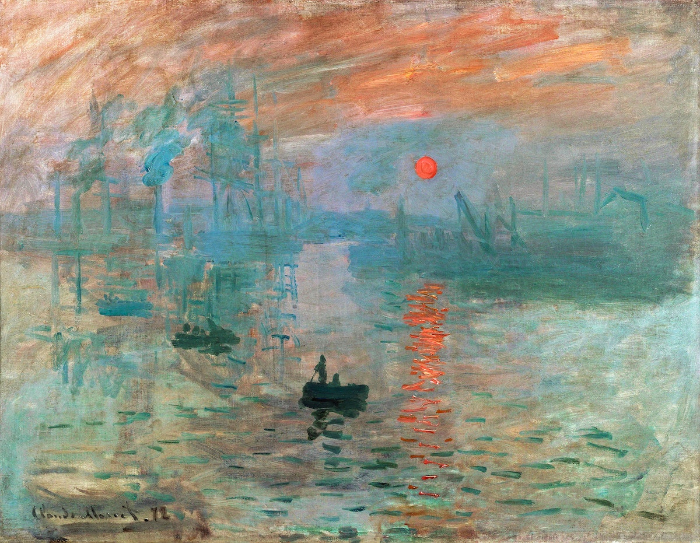 Sunrise, by Claude Monet, 1872
Sunrise, by Claude Monet, 1872In Italian, this means "at first attempt." This term is used to describe paintings that were finished in one session, without working in layers or waiting for the oil paint to dry. It is also known as "wet on wet." The Impressionists mainly used this technique. This was a movement of artists who believed in capturing the quick first impression of a scene.
With Alla prima paintings, there will be no revisiting and correcting. They are swiftly made and are characterized by bold, dynamic brushstrokes. The paintings of Paul Cezanne and Claude Monet (both Impressionists) were primarily made Alla prima.
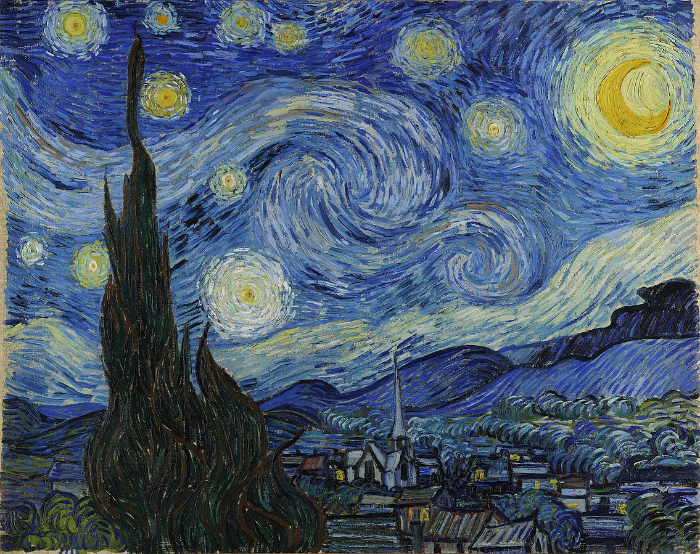 Starry Night, by Vincent Van-Gogh, 1853-1890/Source
Starry Night, by Vincent Van-Gogh, 1853-1890/SourcePointillism
A modern painting technique developed by George Seurat and Paul Signac, pointillism involves meticulously layering paint on the canvas in dots of color. From a distance, the colors seem to mix into other colors, but when you look closely, you can see the colors scatter.
Pointillism is the product of frantic scientific research on light, color theories, and the human retina. Pointillism is based on the assumption that our perception of color changes relative to adjacent colors. Paintings done with this technique break rays of light into thousands of colors, only to be reassembled by the viewer's retina. Some famous pointillism artworks are Entrance to the Grand Canal, Venice – by Paul Signac, Self-Portrait (1887) by Vincent van Gogh, and Portrait of M. Félix Fénéon by Paul Signac. To truly understand pointillism, see below the most famous piece created with this technique, along with a close-up detail that reveals the colors: A Sunday on La Grande Jatte by Georges Seurat (1884). Notice how the painter chose to incorporate blue and red in the girl's face, something we don't see from afar as the dots blend together to create a skin tone.
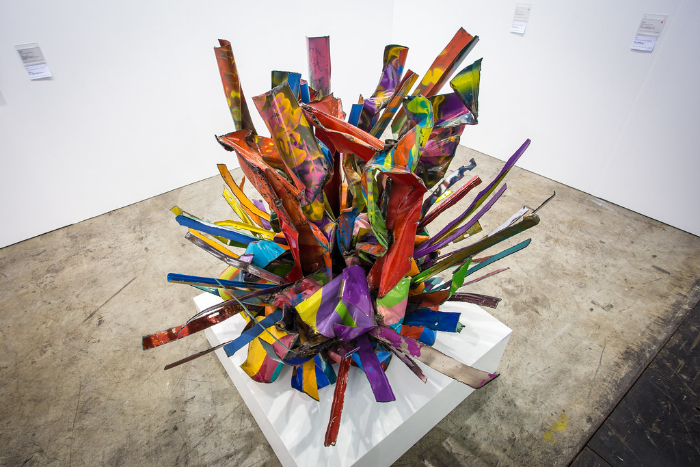 Bloodydrivetrain, by John Chamberlain, 2007/Source
Bloodydrivetrain, by John Chamberlain, 2007/SourceYou may have heard of collage, a term used to describe a work of two-dimensional art composed of cut and pasted flat visuals. When making a collage, visual elements are usually removed from their original context and are combined in a way that conveys a distinct idea. An artist can create the image from scratch or use ready-made visuals - items that already exist in the world.
When the same process is done with three-dimensional objects to create a sculpture, it is called assemblage. When creating an assemblage, the materials are usually not pieces of art. Assemblages are a bold manifestation of postmodernist, futuristic, and contemporary art. In assemblage more so than in collage, there is an element of recycling; usually, the items are ready-made and not sculpted from scratch. Modern artists Robert Rauchenberg and Isa Genzken are famous for their assemblages.
A diptych is a work of two-dimensional art painted on two separate canvases. Similarly, a triptych is made of 3 separate parts.
Diptychs and triptychs aren't one image cut into three. Although there is a connection and a dialogue between these parts of the work, they do not form a puzzle.
Traditionally, triptychs were forms of religious art. They were made of a central wooden panel depicting a significant religious icon, with the other two panels depicting followers or lower-rank characters. The side panels were half the size of the central panel, and they were attached with folding hinges, making the work easily portable.
Diptychs in religious art were made of the same-sized wooden panels attached with a hinge. They depict significant religious figures of the same rank.
One of the most famous non-religious artists who worked with triptychs and diptychs is Hieronymus Bosch.
Lithography
Lithography is a complicated form of manual printing, traditionally done with limestone but can also with aluminum. In this process, an image is drawn on the stone board with a waxy or oily material. After several chemical treatments, the stone becomes like a large stamp you can press to print the same image over and over again. This technique requires special oil-based inks. Famous artists who have used this technique are Diego Rivera, Henri De Toulouse-Lautrec, Roy Lichtenstein, and Andy Warhol.